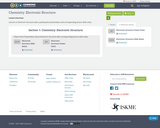
Lecture on Electronic Structure with a powerpoint presentation and corresponding lecture slide notes.

Astronomy, Chemistry and Physics.

Lecture on Electronic Structure with a powerpoint presentation and corresponding lecture slide notes.
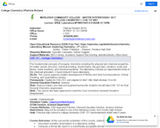
The fundamental concepts of inorganic chemistry including the physical and chemical properties of matter, atomic structure, chemical bonding, stoichiometry, the gas laws, solutions, acids and bases, redox reactions, and chemical equilibria. The laboratory includes an experimental study of the chemical principles. 3 hours lecture/3 hours laboratory.
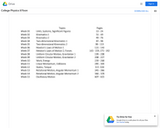
This course is designed for the student in science, electronic technology, or a health profession such as physical therapy. Subject matter covered will include: principles of mechanics, concurrent forces, nonconcurrent forces, friction, elasticity, motion, forces and motion, work and energy, power, impulse and momentum, and simple harmonic motion. A non-calculus approach.
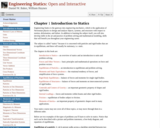
Engineering Statics is a free, open-source textbook appropriate for anyone who wishes to learn more about vectors, forces, moments, static equilibrium, and the properties of shapes. Specifically, it has been written to be the textbook for Engineering Mechanics: Statics, the first course in the Engineering Mechanics series offered in most university-level engineering programs.
This book’s content should prepare you for subsequent classes covering Engineering Mechanics: Dynamics and Mechanics of Materials. At its core, Engineering Statics provides the tools to solve static equilibrium problems for rigid bodies. The additional topics of resolving internal loads in rigid bodies and computing area moments of inertia are also included as stepping stones for later courses. We have endeavored to write in an approachable style and provide many questions, examples, and interactives for you to engage with and learn from.
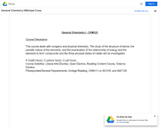
This course deals with inorganic and physical chemistry. The study of the structure of atoms, the periodic nature of the elements, and the examination of the relationship of energy and the elements to form compounds and the three physical states of matter will be investigated.
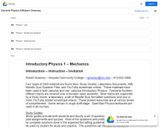
Four types of OER material are found here: Study Guides, Laboratory Documents, XML Moodle Quiz Question Files, and YouTube screencast videos. These materials have been used in both calculus and non- calculus Introductory Physics. Twelve to fourteen different topics are covered over a fourteen week semester. Most topics are supported by a Study Guide, a laboratory, a set of Moodle Quiz formatted questions, and one or more YouTube posted screencast videos. These posted resources are at various levels of completeness. Some remain in rough draft stage. OpenStax Physics textbooks are used in all courses.
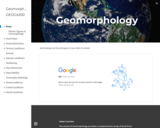
This was an assignment for students in two parts:
(1) for a given week, students sign up for a landform that pertains to the processes we’ll be studying (e.g. landslides, streams, volcanoes, etc…). The student will use wikipedia, govt. agency websites, or primary sources to present a “show and tell” of the landform including 4 things:
a) describe the process by which that feature is formed,
b) give an example of where it can be found,
c) find 3 pictures of the landform, &
d) sketch (or find a depiction) of what the feature would look like on a topographic contour map.
(2) Students will take their presentations and use them to create pages on a Google Sites webpage that will become an online textbook. Students will be able to use the book to study for quizzes on the landforms.
(3) Students will read and leave comments on 2 other students’ pages to provide constructive feedback to help improve the textbook’s content and readability.
Learning Objectives: Students gain oral and written communication skills by presenting and documenting/sharing their research. Students will describe the shape of landforms and connect landforms with the processes responsible for their formation by learning from each other and from doing their own research.
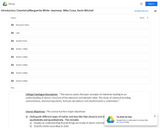
This course covers the basic concepts of chemistry leading to an understanding of atomic structure of the elements and periodic table. The study of chemical bonding, nomenclature, chemical equations, formula calculations and stoichiometry is undertaken.
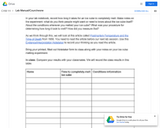
Lab Manual.
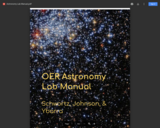
Open source astronomy lab manual, including 21 labs, 6 instructor manuals, a sample lab report, and a sample lab grading rubric. Intended for 100-level non-majors astronomy lab courses, but can also be used with modifications at other levels.
Google Docs: https://bit.ly/Astronomy-Lab-Manual
PDF: https://bit.ly/Astronomy-Lab-Manual-PDF
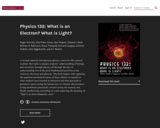
A second semester introductory physics course for life sciences students that looks to deepen students' understanding of biology and chemistry through physics all through the lens of understanding two of the most fundamental particles in the Universe: electrons and photons. The book begins with exploring the quantum mechanical nature of these objects to expand on what students have learned in chemistry and then proceeds to geometric optics (using the human eye as a theme), electrostatics (using membrane potentials), circuits (using the neuron), and finally synthesizing everything in a unit exploring the meaning of "light is an electromagnetic wave."
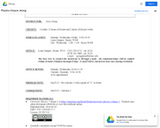
Continuation of Physics 1. Topics include: simple harmonic motion, gravitation, fluid mechanics, waves, the kinetic theory of gases, and the first and second laws of thermodynamics. This course is a calculus-based physics course that is required by four-year colleges in science and engineering studies.

Principles of Chemistry I and II and Lab (SCI123 and SCI124), fulfills the chemistry requirement of biology, pharmacy, premed, prevet, engineering, or chemistry majors. It is expected that the student will go on to the second semester of this sequence Principles of Chemistry II (SCI124) or equivalent; SCI123 is not designed to be a one semester introductory course. This course is generally viewed as a science major introductory chemistry class. If your intended program of study is a physical science, pharmacy, pre-med/pre-vet, or engineering major this course is required. Laboratory work serves to reinforce concepts as well as introduce students to the scientific method, basic laboratory techniques, and the importance of safety in the laboratory environment.
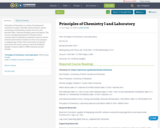
Principles of Chemistry is a study of fundamental chemical concepts: scientific measurements, matter and energy, stoichiometry, atomic structure, the periodic table, chemical bonding, gases and liquids. The course is designed primarily for students with a concentration in biological or physical sciences and for students interested in transfer to a four-year program in engineering. A three-hour lab session is required each week. All course content created by Kimberly Stieglitz. Content added to OER Commons by Julia Greider.

The following OER resources have been created by Mike Cross for Chemistry I:Stoichiometry classroom presentationThese presentation slides are meant to be used by an instructor to introduce the concept of stoichiometry in the classroom. The problems involved can be solved by the instructor on the board or solved by students individually or in groups. The presentation should take approximately 2 ½ hours of class time.Stoichiometry problems (5)These videos show solved the process of solving stoichiometry problems. The first problem is the simplest and the problems increase in difficulty. The video links can be given to students in order to help them learn how to complete these types of calculations.
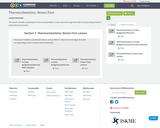
This lesson includes a powerpoint lecture and problem in-class exercise/assignment with corresponding solutions about thermochemistry.